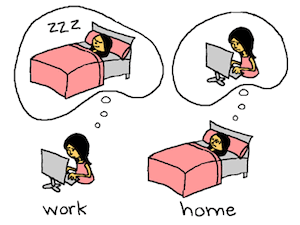How many of the following are familiar to you? Heavy workload with evening and weekend work a regular feature? Donor, budget, and deadline pressure that spills over into your home life? Organisational and staff changes to adapt to? Constantly juggling work/life balance?
 We need to pay attention to how our work is affecting our lives and vice versa, and to the connection between personal and organisational well-being. Denying their connection is common and convenient – but limiting. We often attempt to compartmentalise ourselves into our various life and work roles but it is often not possible to cleanly separate work, home, and social lives. If we flourish and do well in one area, it will often affect the others and vice versa.
We need to pay attention to how our work is affecting our lives and vice versa, and to the connection between personal and organisational well-being. Denying their connection is common and convenient – but limiting. We often attempt to compartmentalise ourselves into our various life and work roles but it is often not possible to cleanly separate work, home, and social lives. If we flourish and do well in one area, it will often affect the others and vice versa.
Ultimately, our well-being affects the well-being of our organisations – and the well-being of our organisations affects our personal well-being. For instance, employees who feel content and motivated in their roles tend to be more productive, which contributes to the financial bottom line. Similarly when there are financial struggles or challenging change processes within the organisation, this can lead to stress for staff.
Well-being isn’t just about our physical health. It’s about our mental and emotional well-being and how connected we feel to our work and to both the people we work with and those we aim to reach. It includes
- How we manage stress and frustration
- Being/feeling resilient in the face of challenges
- Being/feeling sufficiently resourced in terms of time, skill or support
- Work/life balance and a sense of sustainability in our work
- Having a sense of purpose and aligning our work with our values and principles
- Our motivation and drive
- Relationships and fun in the office
- Being able to dedicate time and energy to our life outside of work
- Getting feedback from others that supports learning and growth
According to the All-Party Parliamentary Group on Wellbeing Economics (UK), other factors affecting our well-being include a sense of control at work, skills use, and managerial behaviour.[i]
There is a great deal to be gained from giving staff well-being our attention. It shows that the organisation cares about its staff. When people feel listened to, it creates trust, respect and a sense of being valued. This creates the possibility for transformative change. As Rick James talked about in his recent blog post, ‘Making it Personal’, organisational change comes from cultivating capacity and this is highly personal.
When people’s well-being is not factored into organisational planning, operations, and reviews, the risks are high. Well-being can plummet, along with levels of engagement, learning, and creativity.
There are numerous ways to engage individuals on the subject of personal well-being and collectively consider how this affects the well-being of the organisation:
- Get leaderships support first to gain traction – without this, any initiative is unlikely to gain support.
- Arrange a meeting with a small group where people feel able to share. Pick an environment that lends itself to sharing, perhaps out of the office to create a sense of difference from ‘normal’ meetings. Set up a structure that invites everyone to share without interruption, criticism or judgement (for more on this, see my previous post, ‘Nine ways to turn around the dreaded work meeting’) before moving to a general discussion or any practical actions. There is no right or wrong when talking about our sense of individual well-being.
- Do a staff survey to give an opportunity for comments, with further discussion face to face. Give a sense of what will happen as a result, because otherwise, people may not feel inclined to be honest.
- Hold one-to-one discussions on well-being and feed the overall points into a larger discussion.
- Periodically check in with individuals to explore how their sense of well-being is changing over time
- Hold informal discussions on well-being resources such as ‘The Happy Manifesto’, which some international NGO senior management teams have read and discussed
Once factors affecting well-being have been explored and the general level of well-being has been established, practical actions can then be considered for maintaining or raising the level of well-being. For example, some organisations have incorporated the following into their organisational ways of working:
- Flexible working hours[ii]
- Time off in lieu, overtime or workload adjustments for those working excessive hours
- Courses specifically supporting well-being such as mindfulness (e.g. mindfulness-based stress reduction)
- Team building opportunities
- Social time (Friday biscuits, lunches etc.) to support social relationships
- Bike-to-work schemes and other schemes to support physical well-being
- Management and leadership training which focuses on strong emotional intelligence, staff well-being, and trust building
Just as personal well-being is more than just physical well-being, organisational well-being is more than just the financial position of the organisation. Financial figures get a large share of our attention because they are tangible and trackable. However, just as fundamental are our ways of working, the health of our internal and external relationships, and resilience in responding to internal and external change. Individual well-being affects all of these.
Sadly, some of these topics only get covered in a yearly staff survey or performance review, in an external branding exercise or an evaluation report read by few. We wouldn’t do this with our financial figures. Isn’t it time personal well-being and broader factors affecting organisational well-being got more attention?